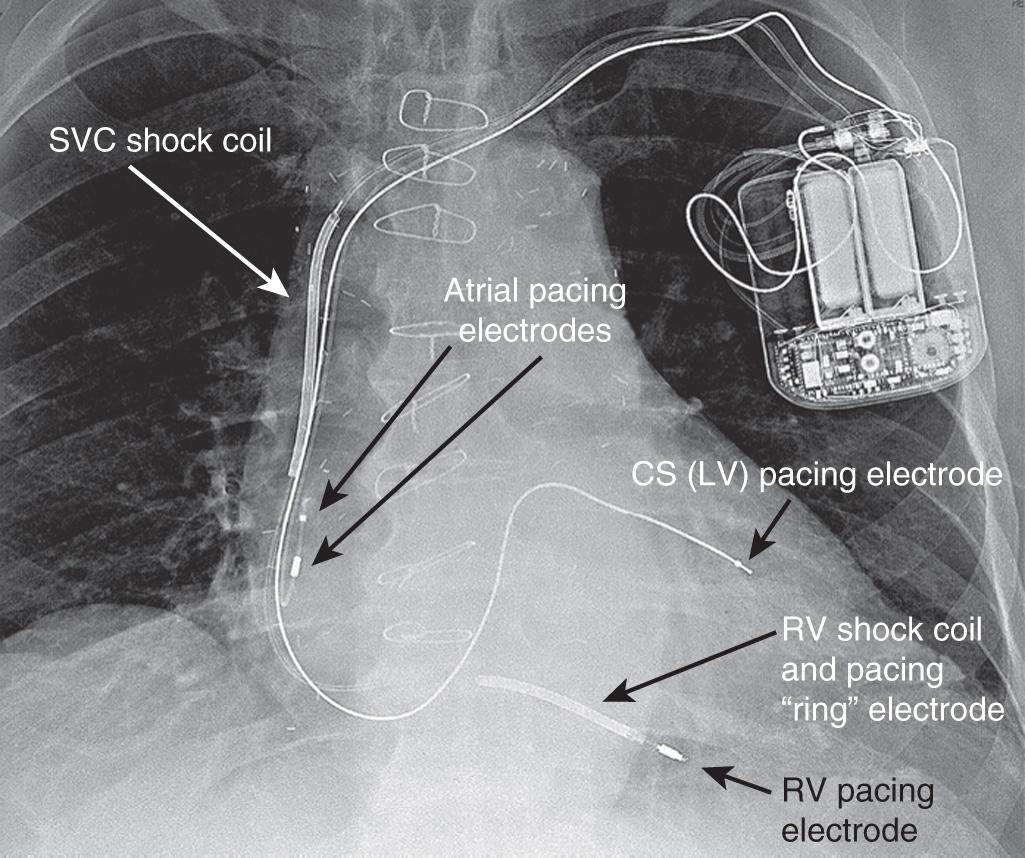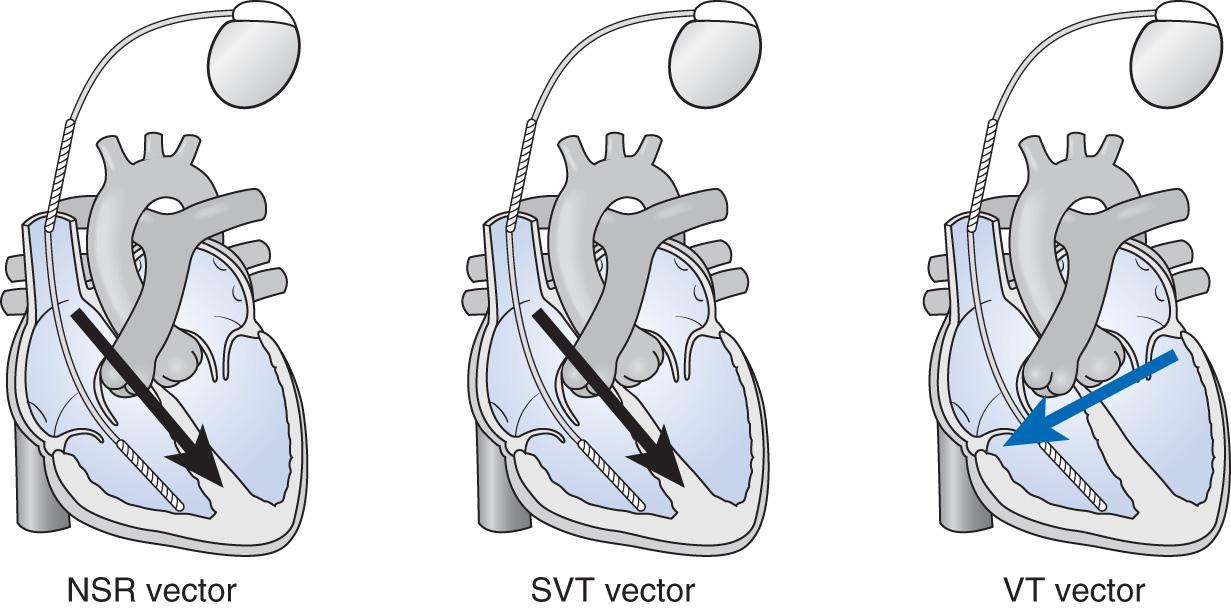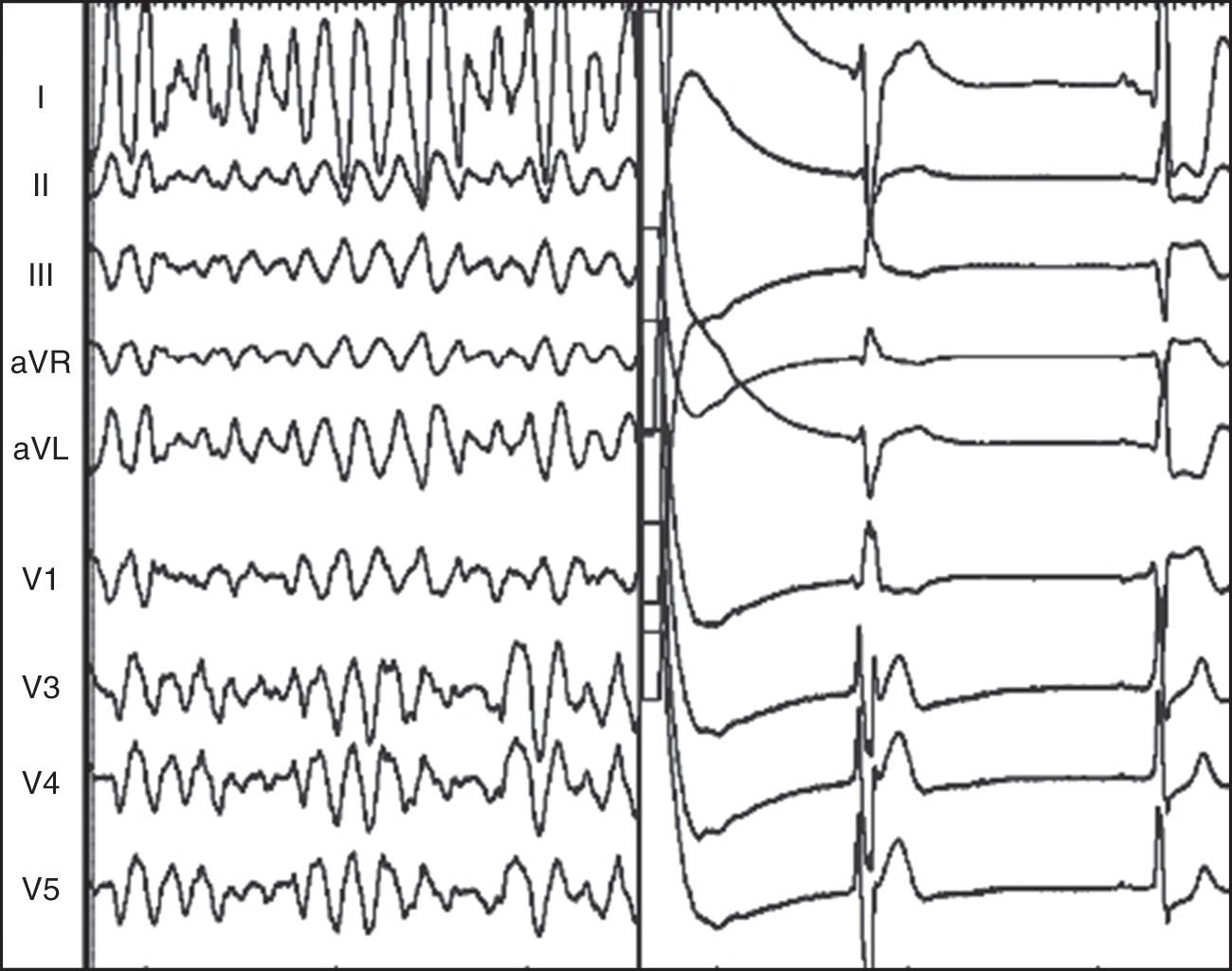Physical Address
304 North Cardinal St.
Dorchester Center, MA 02124
Implantable cardioverter defibrillators (ICDs) are composed of a pulse generator (typically implanted in the left upper chest) and one or more leads. The generator is composed of the electrical circuitry, a battery, and capacitors. It uses nonrechargeable lithium-based batteries that are reliable energy sources with a good safety profile and predictable life expectancy. The internal capacitors allow it to deliver a powerful shock at a voltage much higher than the battery voltage.
Most ICDs are designed to perform all the functions of pacemakers as well. Since many patients in whom an ICD is indicated are also candidates for cardiac resynchronization therapy, some ICDs also have biventricular pacing capabilities ( Fig. 39.1 ).

There are two types of ICDs:
Transvenous ICD (transvenous lead directly attached to the heart, one or multiple leads).
Subcutaneous ICD (only one subcutaneous lead).
Transvenous ICDs are commonly used and can work as pacemakers. These ICDs use transvenous or epicardial leads. These leads usually have two distal electrodes (tip and ring) that can sense local electrical signals and be used for cardiac pacing. The right ventricular lead of a defibrillator differs from those of pacemakers by incorporating one or two coils (one located in the right ventricle and the other in the superior vena cava) through which the high-energy shock is delivered. Much less commonly, epicardial patches placed directly on the surface of the heart during surgery are used in place of transvenous lead coils. Additional transvenous or epicardial leads may also be used for atrial and biventricular pacing.
The subcutaneous ICD has a lead that runs under the skin but outside of the ribcage, which is used only for defibrillation and not for pacing.
The ICD is always sensing the electrical signals of the heart and processes them to detect the rhythm. Sensing refers to the process for determining the timing of a cardiac depolarization. Detection refers to the sensing of a particular cardiac rhythm from the sequence of cardiac depolarizations. The arrhythmia detection criteria are met by counting beat-to-beat intervals between successive electrograms. If ventricular tachycardia (VT) is detected, the ICD tries to restore a normal rhythm. The first strategy for achieving this is usually to transiently pace the ventricle faster than the VT, which is known as antitachycardia pacing. If one or more tries at this fail, then the ICD sends a high-energy shock to the heart to restore a normal rhythm. The device then goes back to its watchful mode.
The criteria to detect arrhythmias and the nature of the therapies provided can be programmed based on the patient’s specific clinical need. The ventricular arrhythmias are detected based on beat-to-beat intervals (shorter RR intervals correspond to faster heart rates). There are usually up to three zones: a monitor zone, a VT zone, and a ventricular fibrillation (VF) zone. Arrhythmias with the shortest intervals/fastest rates will fall into the VF zone, those with longer intervals/slower rates than VF will fall in the VT zone, and the monitor zone is usually for detecting but not for treating even slower arrhythmias such as supraventricular tachycardia (SVT) or slow VT.
Once the arrhythmia is classified into a zone, discrimination algorithms are usually employed to distinguish whether the rhythm is more likely to be VT or SVT (atrial fibrillation or flutter, SVT, or sinus tachycardia) in origin ( Fig. 39.2 ). These discrimination algorithms use criteria including abrupt versus gradual tachycardia onset, regularity or irregularity of the rhythm, QRS morphology, and QRS vector. If the ICD algorithms determine that the rhythm is ventricular in origin, the therapies programmed for the selected zone will be delivered. Once a therapy is delivered, the ICD monitors the following intervals to redetect the arrhythmia (which means the therapy was unsuccessful), which results in additional therapy. An example of a successful ICD shock for torsades de pointes is shown in Fig. 39.3 .


ICD therapy, compared with conventional or traditional antiarrhythmic drug therapy, has been associated with mortality reductions from 23% to 55%, with the improvement in survival due almost exclusively to a reduction in sudden cardiac death (SCD). ICD defibrillation can terminate VT, torsades de pointes, and VF ( Tables 39.1 and 39.2 ).
Trials of ICDs are categorized into two types:
Primary prevention trials, in which the subjects have not experienced life-threatening sustained VT, VF, or resuscitated cardiac arrest but are at risk; and
Secondary prevention trials, involving subjects who have had an abortive cardiac arrest, a life-threatening VT, or VT as the cause of syncope.
Become a Clinical Tree membership for Full access and enjoy Unlimited articles
If you are a member. Log in here